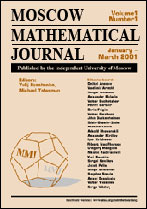|
This article is cited in 18 scientific papers (total in 18 papers)
The boundary of the Gelfand–Tsetlin graph: new proof of Borodin–Olshanski's formula, and its $q$-analogue
Leonid Petrovab
a Dobrushin Mathematics Laboratory, Kharkevich Institute for Information Transmission Problems, Moscow, Russia
b Department of Mathematics, Northeastern University, 360 Huntington ave., Boston, MA 02115, USA
Abstract:
In their recent paper, Borodin and Olshanski have presented a novel proof of the celebrated Edrei–Voiculescu theorem which describes the boundary of the Gelfand–Tsetlin graph as a region in an infinite-dimensional coordinate space. This graph encodes branching of irreducible characters of finite-dimensional unitary groups. Points of the boundary of the Gelfand–Tsetlin graph can be identified with finite indecomposable (= extreme) characters of the infinite-dimensional unitary group. An equivalent description identifies the boundary with the set of doubly infinite totally nonnegative sequences.
A principal ingredient of Borodin–Olshanski's proof is a new explicit determinantal formula for the number of semi-standard Young tableaux of a given skew shape (or of Gelfand–Tsetlin schemes of trapezoidal shape). We present a simpler and more direct derivation of that formula using the Cauchy–Binet summation involving the inverse Vandermonde matrix. We also obtain a $q$-generalization of that formula, namely, a new explicit determinantal formula for arbitrary $q$-specializations of skew Schur polynomials. Its particular case is related to the $q$-Gelfand–Tsetlin graph and $q$-Toeplitz matrices introduced and studied by Gorin.
Key words and phrases:
Gelfand–Tsetlin graph, trapezoidal Gelfand–Tsetlin schemes, Edrei–Voiculescu theorem, inverse Vandermonde matrix, $q$-deformation, skew Schur polynomials.
Received: September 17, 2012
Citation:
Leonid Petrov, “The boundary of the Gelfand–Tsetlin graph: new proof of Borodin–Olshanski's formula, and its $q$-analogue”, Mosc. Math. J., 14:1 (2014), 121–160
Linking options:
https://www.mathnet.ru/eng/mmj517 https://www.mathnet.ru/eng/mmj/v14/i1/p121
|

| Statistics & downloads: |
| Abstract page: | 302 | | References: | 79 |
|




 Contact us:
Contact us: Terms of Use
Terms of Use
 Registration to the website
Registration to the website Logotypes
Logotypes








 Citation in format
Citation in format 
